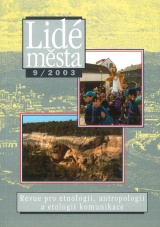Jazyk jako nástroj sociální diverzifikace
Poznámky k jazykové situaci ve Stonavě na Těšínsku
DOI:
https://doi.org/10.14712/12128112.4246Abstrakt
A contemplation about language as a product of social diversification has led us to the statement that the Stonava residents speaking Czech, Polish or with a dialect in various types of communication, which means in various social contexts, too, relate themselves to various specific ideological anchoring of culture which they perceive as their referential framework. This fact can be demonstrated both explicitly with the case of their public speech when the use of Polish refer to the consciousness of their own ethnic roots and the political demands raised by these spokesmen. At the same time, one can highlight the implicit expectations in the background of any language speech. In our case, this is the assumptionof an agreement of the recipient and author of the language speech concerning a specific pre-definition of a referential framework of the speech (such as when using the phrases "Polish year" or "najazd czeski" in recollections). This means to a large extent that this is the language style conditioned by the interpretation of history or understanding of social reality, the style which is much reproduced on the institutional level. The contemplation about language as an index of social diversification points to the existence or a number of more or less autonomous, interrelated and isolated groups in Stonava. Wc can identify the groups on the basis of: a) the length of stay in the town: old residents as against the newcomers when "old residence" is measured by language proficiency and performance, which means the ability to understand and actively use the local dialect; b) ethnic identification, which is at present the most frequent reason of choice of the Polish ethnic educational system. Finally, in the case of language as an instrument of social diversification one has to take into account that language appears here as a constitutional element of a society through which a dynamic community of Stonava residents is formed. The alteration of language codes according to the context bears witness of the consciousness of the existence of these groups and it cements unification on the level of importance when both lauguage codes are used in parallel (the case of public speech). As a result, if we think of language as an instrument of social diversification, this does not automatically mean that the language statification also leads to the diversification in content. lt often happens, also in the case of Stonava, that interpretations of various events are closely connected witb the communication code through which these events are described. This is why we can perhaps think of some communities of a sbared language. However, we also find the situations when the real split of a local society into these communities of a shared language and communication groups is bridged by a generally accepted content of the public speech. The existing language differentiation of the Stonava residents in such public speeches then basically only serves the emphasis and underlining of the importance of these speeches and to the unification which occurs through them.
Stahování
Publikováno
Jak citovat
Číslo
Sekce
Licence

Tato práce je licencována pod Mezinárodní licencí Creative Commons Attribution-NonCommercial-NoDerivatives 4.0.


